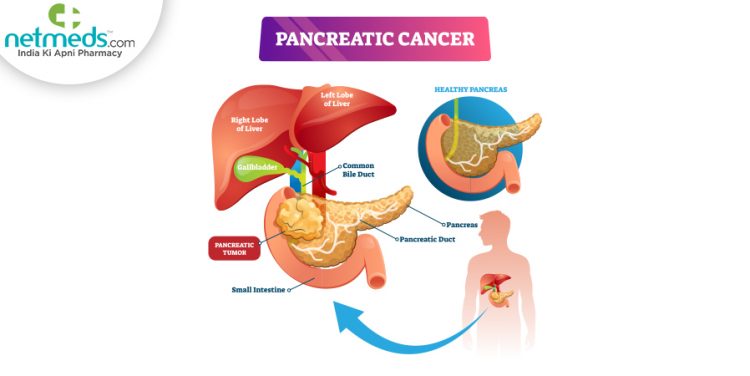When it comes to revealing cancer signs, pancreatic cancer poses a great challenge, and it is referred to as a silent ailment. Since it typically doesn’t show any apparent signs and symptoms in its early stages. Healthcare providers can’t detect an early pancreatic tumour during a regular physical check-up.
The pancreas is located deep behind the stomach in the upper left abdomen. The gallbladder, liver, and spleen surround the pancreas. Thus, if cancer develops in the pancreas, one may not notice until it’s grown too large. By the time symptoms exhibit, the tumour would have spread beyond the pancreas to other parts of the body.
With other types of cancer like breast or colon cancer, patients undergo routine screenings, including mammograms and colonoscopies, irrespective of whether they are showing any symptoms. But these diagnostic tests are not available for pancreatic cancer. Also, when symptoms do appear, they may be easily confused with other illnesses. Other common health conditions like ulcers and pancreatitis share similar symptoms.
The symptoms of pancreatic cancer are the same for men and women. Having one or more symptoms doesn’t indicate that you have pancreatic cancer, but if you observe any of the below symptoms and especially more than one, then seek immediate medical advice.
Also Read: Pancreatic Cancer: Causes, Symptoms And Treatment
Warning Signs of Pancreatic Cancer
The symptoms of pancreatic cancer first appear as jaundice or a yellowing of the skin and whites of the eyes, which is caused due to large amounts of bilirubin enzyme secreted by the liver. Sudden weight loss is also a common warning sign of pancreatic cancer.
Other signs include:
- Dark-coloured urine
- Light-coloured stools
- Itchy skin
- Fatigue
- Digestive issues such as abnormal stools, nausea, or vomiting
- Pain in the upper abdomen
- Poor appetite
- Swollen gallbladder
- Blood clots
- Diabetes
Symptoms Of Pancreatic Cancer
Jaundice
Though jaundice is not commonly caused by pancreatic cancer, it’s generally one of the first symptoms of pancreatic cancer, and it’s always experienced by pancreatic cancer patients. The liver produces bile, which contains bilirubin and during the process of digestion, bile travels via the common bile duct into the intestines to help the breakdown of fats, which are then excreted in the stool.
Also Read: Jaundice In Adults: Causes, Symptoms And Treatment
But if the bile duct is blocked due to a tumour that begins in the head of the pancreas, then bilirubin may accumulate causing jaundice. In a few cases, even small cancers may press on the duct, enabling the healthcare provider to find out cancer at an initial stage. However, cancers that originate in the body or tail of the pancreas, don’t start to press on the duct until it had spread via the pancreas and at times to other vital organs- mainly the liver, which also aggravates jaundice.
Back/Belly pain
Abdominal pain is a classical symptom of pancreatic cancer, as any cancerous cells that have grown large begin to be pressing on nearby organs, causing discomfort and pain. Also, the pain radiates to the back, because of spreading to nerves surrounding the pancreas.
However, back and belly pain may also imply other problems besides pancreatic cancer, so it’s vital to discuss with your doctor if you’re experiencing pain often.
Nausea And Vomiting
When tumours have spread to the end of the stomach it may partially impede the normal flow of food via the digestive system. This may result in nausea, vomiting and intense pain after eating.
Gallbladder Or Liver Swelling
When a cancerous growth blocks the bile duct, the gallbladder may fill up with high levels of bile and enlarge. In such cases, the doctor may be able to find the swelling (under the right rib cage) during a regular physical exam. Also, these tumours are visible in imaging tests like computed tomography (CT) scan or magnetic resonance imaging (MRI).
Further, the liver may also swell, especially if cancer has spread and this can also be identified through imaging.
Weight Loss And Poor Appetite
Sudden weight loss is very common in people with pancreatic cancer and these people most often have poor or no appetite.
Blood Clots
At times, the initial sign that someone has pancreatic cancer is a blood clot in a large vein, mostly the leg and it is called deep vein thrombosis (DVT). Symptoms include pain, swelling, redness, and warmth in the affected leg. Sometimes, a clot can break off and travel to the lung, which can make it difficult to breathe or cause chest pain. A blood clot in the lungs is medically termed as pulmonary embolism.
Yet, having a blood clot does not typically mean that you have cancer, as most blood clots are caused by other factors.
Diabetes
In rare cases, pancreatic cancer may cause diabetes as they destroy the insulin-producing cells. Most often, cancer can result in some alterations in blood glucose levels, that don’t cause symptoms of diabetes but can still be identified with blood work.
Source by www.netmeds.com


